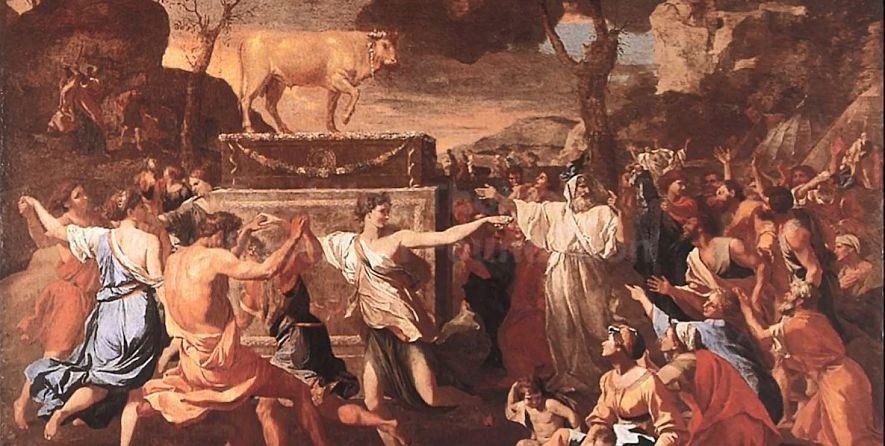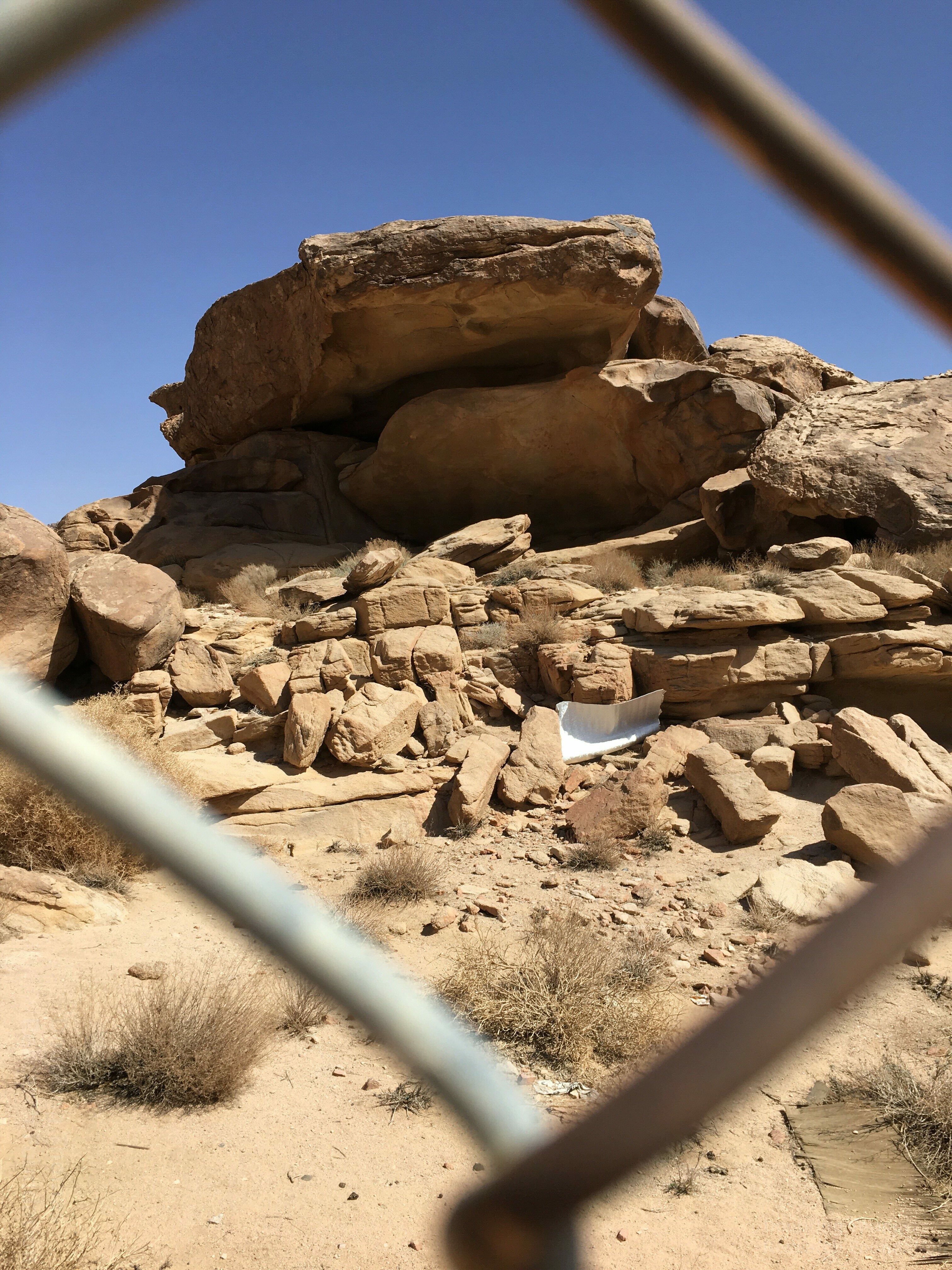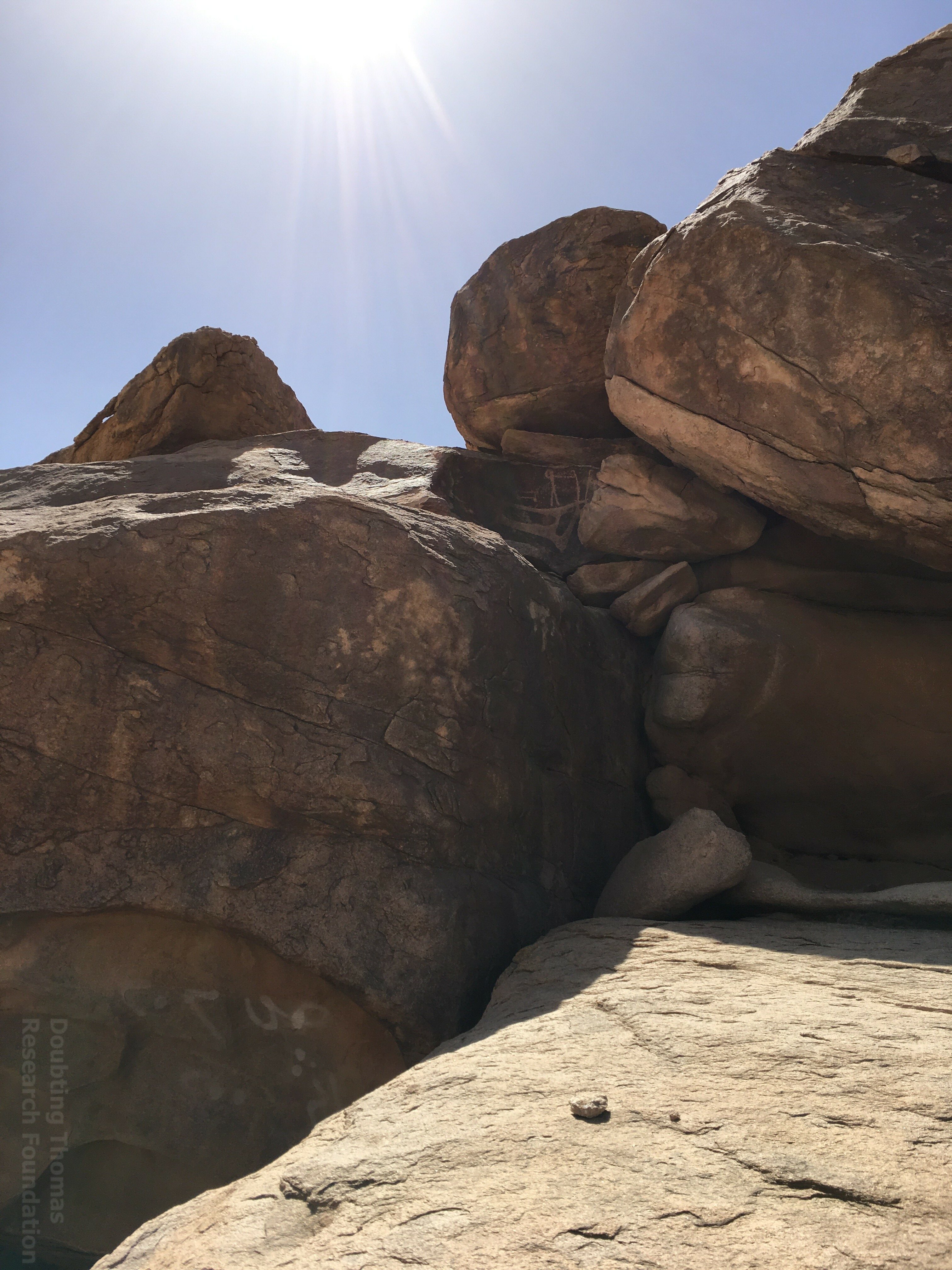The Golden Calf Worship Site

The book of Exodus recounts that some of Moses' followers rebelled after he was on Mount Sinai longer than expected. Apparently believing that Moses died or gone missing, they pressured Aaron into creating a golden calf to worship as a representation of God.
The choice of the golden calf is believed by many scholars, as well as we here at DTRF to reflect a brief return to worship of the Egyptian bull gods of Apis and Hathor. It is also possible that they were adopting local bull worship practices they may have witnessed in Midian.
The worship appears to involve more depictions of bulls than just the golden calf alone, as the Exodus story records these rebellious Israelites as saying, "These are your gods, o Israel, who brought you out of the land of Egypt."
Exodus 32:1-2 recounts:
When the people saw that Moses was so long in coming down from the mountain, they gathered around Aaron and said, “Come, make us gods who will go before us. As for this fellow Moses who brought us up out of Egypt, we don’t know what has happened to him.”
Aaron answered them, “Take off the gold earrings that your wives, your sons and your daughters are wearing, and bring them to me.” So all the people took off their earrings and brought them to Aaron. He took what they handed him and made it into an idol cast in the shape of a calf, fashioning it with a tool. Then they said, “These are your gods, Israel, who brought you up out of Egypt.”
The worship involved a noisy scene, with burnt and fellowship offerings being given to the golden calf along with objectionable acts (Exodus 32:6). The Apostle Paul later wrote in the New Testament that this scene included sexual immorality (1 Corinthians 10:7-8).
The golden calf would presumably have been placed on top of a high stand in order to be seen and exalted. The Exodus story also says that Aaron set up an altar in front of the golden calf (Exodus 32:5).
While he was on Mount Sinai with the 10 Commandments, God told Moses of the rebellion happening down below. Moses heard the wild noise and saw the golden calf as he walked down the mountain. This further indicates that the golden calf was on a stand or something that made its display prominent.
In anger, Moses then smashed the tablets with the 10 Commandments written on them, an act which also served as an allusion to the breaking of the covenant with God.
Moses melted the golden calf and ground it into powder. He then sprinkled the remains of the calf into the nearby stream that flowed down from Mount Sinai. The Golden Calf worshipers were forced to drink from the polluted stream.
He then ordered the execution of 3,000 people who worshiped the Golden Calf. Another 20,000 Israelites died from a divine plague. The Apostle Peter wrote that the plague killed the 20,000 on the same day that the worshipers were executed (1 Corinthians 10:7-8).
Based on the story, the following evidence could be found at Mount Sinai true location:
1) A possible Golden Calf worship site with evidence of bull worship near the mountain - such as petroglyphs or carvings of bulls in a ritualistic fashion;
2) A high stand upon which the golden calf can be seen and worshiped;
3) Evidence of gold;
4) An altar, or structure resembling an altar, in front of the stand;
5) The worship site must have enough flat land to accommodate a crowd of thousands of worshipers;
6) The site must be close to, or on, a massive plain where the Israelite population camped;
7) A brook must flow down from the mountain and near the worship site, or evidence of such must exist;
8) Evidence of a mass burial of the 23,000 worshipers.
Possible Golden Calf Worship Site Near Jabal Maqla
There is a distinct site with evidence of bull worship located about 1.8 miles from the base of Jabal Maqla. The Saudis have a security fence around the site and a sign in both Arabic and English confirming it is of archaeological significance. According to the Saudi authors of Al-Bid' (History and Archaeology), the Ministry of Museums and Antiquities put up the fences in response to vandalism of these sites over the years.
The sign warns trespassers of severe consequences if one breaches the fence. Saudi police are known to patrol the area and approach those who do not appear to live in the area.
There is a local tradition that it is where the golden calf episode took place, and that gold is buried underneath the site. Saudi police and locals are known to suspect outsiders of hunting for that gold.
The site has a pile of large rocks with many petroglyphs of bulls and people worshiping bulls. For instance, at a rock pile a bit closer to the mountain, one petroglyph shows a person holding a bull up above his head like an act of praise. There are approximately a dozen groupings of such petroglyphs at this site.

The depictions do appear to resemble the Egyptian bull god Apis and cow goddess Hathor. However, there is disagreement over whether they can be accurately described as "Egyptian-style" bulls, or if they are unique to this area in particular.
Dr. Charles Whittaker wrote in his 2003 dissertation that there are clear similarities, but added a note of caution:
"However, all the bovine etchings in Saudi Arabia could have a general likeness to the Apis bill. Therefore, one must give convincing evidence that the bulls on the Lawz site are the cultic bull, distinguishing them from al others, if one is to distinguish this site as anything other than a Bedouin rock art billboard showing drawings of cattle."
A remarkable similarity between a painting of bull worship on a tomb in Egypt and one of the petroglyphs at this site was noticed by Dr. Lennart Möller, author of The Exodus Case.

The horns on the bull in Saudi Arabia are similar to those seen on the Egyptian bull god Apis. Even the shape of the worshiper's head appears to be copied.
Larry Williams, a Wall Street trader who traveled to the site with Bob Cornuke in the 1980s, quoted an archaeologist from the University of Riyadh as saying "These drawings are the Hathor and Apis bull from Egypt--I have never seen them in this country before."

The Saudis deny that any archaeologist from their country said such. The Saudis also say that bovine worship was common in northwestern Saudi Arabia at the time of the Exodus, and that the existence of these petroglyphs is not evidence of Egyptian influence.

A number of sources confirm that depictions of ancient bull worship are not unusual in Saudi Arabia. The Livingstone Epigraphic Survey recorded that such petroglyphs are most common in the northwest part of the country.
Dr. Whittaker also pointed out that the style of the bull drawings is not an exact match with others he reviewed in Egypt. The ones in Saudi Arabia have horns that are longer and curved at the end, whereas the Egyptian ones are more vertical. Of course, it is unclear how diverse the depictions of bulls in Egypt were, and how much artistic creativity would be allowed in drawing the petroglyphs.

It has also been argued that the bovine inscriptions in the Aiduma Hills of southwestern Saudi Arabia actually look more like the Egyptian Apis bulls than those at this site.
What is arguably significant about this site is its size, remote location, and the nearly singular focus on the bull.
The structure is high and visually impressive. There's clearly an intense devotion at the site to bulls. However, the petroglyphs are limited to this remote site.

The bull petroglyphs do not spread beyond it, with the exception of a single display near the base of the mountain. It gives the impression that the bull worship arose suddenly and only briefly at this location and it is unclear why it would happen here.

In Al-Bid' (History and Archaeology), Saudi archaeologists confirm that the petroglyphs date back to between 3,000 B.C. and 1,500 B.C., with those dates being a relative estimate. This timeframe is very broad but certainly compatible with the Exodus account. A close reading of the Biblical text indicates that a non-Israelite origin of the petroglyphs is also compatible with the text, if that is indeed the case.
The Style of Worship
Dr. Miles Jones, author of The Writing of God, says that the depictions of how people were worshiping the bulls is significant and indicates the petroglyphs were drawn by people from Egypt. The petroglyphs show nude dancing and jumping around the bulls and the bovines have Egyptian-like characteristics, he says.
The scenes are so unique that there are only two other places with identical scenes: Crete in Greece, and, of particular note, the area of Egypt where the Bible says the Israelites were enslaved.
Red-Painted Bulls
On one side of the pile of large rocks, there are a few faint paintings of bulls in red. These depictions have only been noticed in recent years. The drawings are different stylistically from the petroglyphs.
When our associates attended an archaeological conference in Riyadh in 2017, the experts said that bull petroglyphs, including depictions of bovine worship, are common throughout Saudi Arabia.
However, painted bulls are rare and very significant, it was stated. The archaeologists did not mention the images at this site or the overall topic of Mount Sinai.

"Daily Life" Rock
There is similar art on a rock pile closer to the base of the mountain that may be related to the Golden Calf episode. The Saudis have not erected a security fence around it, nor set up a sign identifying it as an archaeological sign. The general area is patrolled by police, however.
This site has been referred to as the "Daily Life Rock" because it shows various scenes. It may depict the Golden Calf worship, but it is not solely focused on that act. It seems more likely that it is telling a story or multiple stories.
One image that is noteworthy is a line of cattle with men in between them. It is reasonably speculated that this shows the lining up of oxen for sacrifice at Moses' altar at the foot of the mountain, which is nearby. The rock also appears to show naked males dancing around bulls and scenes of hunting or warfare. It is plausible that this is a depiction of the Golden Calf worship, and the subsequent killing of those worshipers.
Other animals shown include goats or rams, dogs, sheep, snakes, and animals that might be cats. There are also bovines that do not appear to be worshiped. Dr. Whittaker writes that several of the bulls on this rock have horns that are more similar to the Egyptian Apis god than the ones seen at the possible Golden Calf worship site.
The Golden Calf Stand
The stand for the Golden Calf must have been high enough for Moses to see it as he descended from Mount Sinai. The logistical requirements are met by this site's rock structure.
The pile of rocks can be climbed relatively easily, and there is a flat top where the Golden Calf could have been placed. There is a discolored, circular indentation at the top that is very distinct. It is possible that this is where Moses ground the calf into powder.

The highly controversial amateur archaeologist Ron Wyatt reported that he climbed the rock pile in the 1980's after a light rainfall. He claimed that the water had an unexpected reddish/orange tint, causing him to look more closely. He believed he saw tiny specs of gold that accounted for the coloring of the rainwater.
If this is where the Golden Calf worship took place, it is most likely that this pile of rocks fell together naturally and was not constructed by Aaron and the worshipers. The Biblical text does not indicate that the rebellious Israelites invested a significant amount of labor and time. The large size of these rocks would require a tremendous amount of time and labor to move.
Golden Calf Altar
This pile of rocks has sometimes been referred to as the "Golden Calf altar," a description that our on-site review leads us to believe is in error.
The Exodus story places the altar in front of the golden calf. While it says that Moses destroyed the Golden Calf, it does not explicitly say that he destroyed the altar in front of it where burning and fellowship sacrifices took place.
If the altar still exists, there are two candidates at the site. The most likely candidate for the Golden Calf altar is in front of the pile of rocks that we believe is the Golden Calf stand.
It is a rectangular rock on a raised platform that appears purposeful and perhaps assembled by men. The rock has a flat slide, potentially suitable for sacrifices. It is also balanced at an angle, which would theoretically allow the blood to drain off the side.
The Saudis' inclusion of the spot in the fenced-off area may be telling. It is far enough from the Golden Calf Stand that the logical place for the fence would be between it and the stand.
The Saudis apparently judged that it has archaeological significance, and is related to the piles of rocks with the petroglyphs. This structure also bears a strong similarity to another possible altar at the very bottom of the hill with the Split Rock.
There is a second, less likely option is a log-shaped rock on the top of the pile that seems purposely placed. It is near the aforementioned circular indentation, so it is plausible that this was in front of the Golden Calf.
This explanation sounds appealing at first, but there are several logistical problems with suggesting this as the altar.
First, it probably would have blocked the view of the Golden Calf from several angles, especially during the offering of sacrifices. Second, it would make the offerings an unnecessarily complicated and perhaps impossible process as it would require a climb to the top.
Gold?
There is no definitive proof of gold at this time, but the necessary equipment for detection hasn't been brought to the site since the 1980s.
As mentioned before, the widely-criticized amateur archaeologist Ron Wyatt claimed to have seen tiny specs of gold in reddish-water that collected on the top of the Golden Calf stand. Our research does not indicate that Wyatt engaged in any deliberate deception in regards to his expeditions of this area.
David Fasold, a U.S. Merchant Marine officer and amateur archaeologist, traveled to this site with Wyatt in 1985 and was arrested by Saudi police. He said that he brought the necessary equipment and detected gold buried somewhere within the vicinity of the Golden Calf worship site.
Local Saudi tradition is that gold is buried under the Golden Calf worship site, and closer to the foot of the mountain. There is a deep hole with a ladder in it at the bottom of the mountain where local Saudis claim that government personnel retrieved buried gold.
The tradition is so strong that locals say that the police patrolling the area suspect visitors of being gold and treasure hunters.
Saudi Response
The Saudi government's published responses to the Mount Sinai theory reject the idea that these finds are evidence of the Exodus story.
The Saudi Deputy Minister of Antiquities said:
“There is no doubt that the animal representations at the foot of Jabal al Lawz and its surroundings were part of the overall cultural tradition. However, there is no correlation between the cattle figures located on and near Jabal al-Lawz and those worshipped in Egypt during Moses’ time is to say during the 13th century BC.”
The Saudi statements are exaggerated, and claim there is no resemblance between the bull worship scenes at this site and those in Egypt.
However, as Dr. Charles Whittaker writes:
"[A] thorough perusal of depictions of Apis and Hathor would indeed present similarities. This strong statement seems to indicate an intention to distance oneself from the Mosaic connection at all costs."
The Saudis claim that the petroglyphs were created between the Neolithic and Nabataean Periods, a huge span of time leaving a tremendous room for error and denial of their potential significance. But the rock art strongly appears to have been created all at the same time and not through different periods.
One of the Saudis’ claims is that the “patched bovine” hieroglyphs date to the Neolithic Period, a “considerably earlier” timeframe than the Late Bronze Age when the Exodus is usually thought to have taken place.
In other words, the Saudis claim some of the petroglyphs are too old to have be linked to the Exodus, at least conceding that the rock art is not modern handiwork. However, the Saudis’ dating of other parts of the rock art actually lines up with the Exodus timeframe.
"Petroglyphs of human and animal figures may be attributed to a period 3,000 BC to 1,500 BC. The dating is relative and tentative based on the cultural objects located in the vicinity or near the rock art sites," the Saudis say.
They also point out that Nabataeans lived in northwest Arabia and suggest that evidence of this population may be falsely attributed to other populations.
The evidence cited are artifacts such as pottery and tools. But of course, populations move in and out of certain areas over time. The finding of Nabataean items in an area does not mean that all evidence of human activity is attributable to them. It certainly is not a strong basis for dating rock art.
The aggressive tone of the Saudi publication is unusual for a supposedly academic and objective document. It is particularly interesting how the Saudis did not emphasize the need to be cautious about dating rock art (and archaeological finds more broadly) because such estimates often change.
As a professor in London told Dr. Whittaker, “You must be aware that dating rock art is a highly inexact science.”
The definitive nature of the Saudis' published conclusions is a strong indication of bias and perhaps a predetermined objective of undermining agenda the theory that Jabal Maqla is Mount Sinai. Is there something they are trying to hide here?

Last updated July 24, 2019.

Wonderful goods from you, man. I have understand your stuff previous
to and you’re just extremely excellent. I really like what you’ve
acquired here, certainly like what you’re saying and the
way in which you say it. You make it entertaining and you still take care of to keep it sensible.
I can not wait to read much more from you. This is actually a terrific website.
Fasold was there in 1985 with Ron Wyatt and not 1986.
This may be a stretch of logic, but perhaps the Israelites saw these stone age depictions of bulls (if in fact, the inscriptions are much older than the Exodus era), and perceived these inscriptions as a sign from Apis, or Hathor. Something like a “supernatural Stockholm syndrome,” where the former captives adopt the superstitions of their past slave masters. I wonder if any bull depictions were altered, especially the horns? Visually, I’m not seeing any indications.